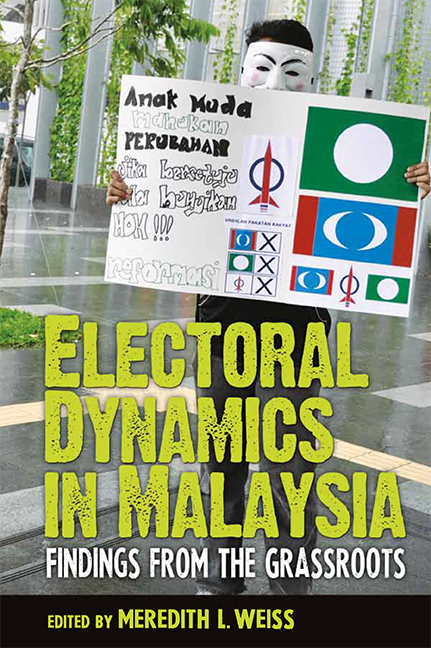Book contents
- Frontmatter
- Contents
- List of Tables
- Foreword
- Acknowledgements
- Glossary & Acronyms
- Chapter 1 Introduction: Patterns and Puzzles in Malaysian Electoral Dynamics
- Chapter 2 Arau, Perlis: The Irresistible Charm of Warlords, Women and Rewards?
- Chapter 3 Padang Serai, Kedah: Between the ‘Personal Touch’ and the Generous Hand
- Chapter 4 Kuala Nerus, Terengganu: New Malay Politics?
- Chapter 5 Balik Pulau, Penang: Home Run for the Home Boys
- Chapter 6 Lumut, Perak: Patronage, Clientelism and the Post-Coup Order
- Chapter 7 Kuantan, Pahang: Revealing the Ordinary
- Chapter 8 Pandan, Selangor: New Electoral Dynamics in Urban Malaysia
- Chapter 9 Kepong and Titiwangsa, Kuala Lumpur: Messages or Money?
- Chapter 10 Rembau, Negeri Sembilan: Personalities and Promises
- Chapter 11 Pulai, Johor: A Tale of Two Coalitions
- Chapter 12 Gelang Patah, Johor: Did Lim Kit Siang Truly Win His Last Gamble?
- Chapter 13 Kota Marudu and Keningau, Sabah: Personality, Patronage and Parochial Politics
- Chapter 14 Tuaran, Sabah: Party Loyalty and Rational Voting
- Chapter 15 Kota Kinabalu, Sabah: BN Loses Its ‘Fixed Deposit’
- Chapter 16 Beaufort, Sabah: Whither Lajim's Popularity?
- Chapter 17 Sibu and Lanang, Sarawak: Defeat of the Bosses
- Contributors
Chapter 15 - Kota Kinabalu, Sabah: BN Loses Its ‘Fixed Deposit’
Published online by Cambridge University Press: 10 November 2017
- Frontmatter
- Contents
- List of Tables
- Foreword
- Acknowledgements
- Glossary & Acronyms
- Chapter 1 Introduction: Patterns and Puzzles in Malaysian Electoral Dynamics
- Chapter 2 Arau, Perlis: The Irresistible Charm of Warlords, Women and Rewards?
- Chapter 3 Padang Serai, Kedah: Between the ‘Personal Touch’ and the Generous Hand
- Chapter 4 Kuala Nerus, Terengganu: New Malay Politics?
- Chapter 5 Balik Pulau, Penang: Home Run for the Home Boys
- Chapter 6 Lumut, Perak: Patronage, Clientelism and the Post-Coup Order
- Chapter 7 Kuantan, Pahang: Revealing the Ordinary
- Chapter 8 Pandan, Selangor: New Electoral Dynamics in Urban Malaysia
- Chapter 9 Kepong and Titiwangsa, Kuala Lumpur: Messages or Money?
- Chapter 10 Rembau, Negeri Sembilan: Personalities and Promises
- Chapter 11 Pulai, Johor: A Tale of Two Coalitions
- Chapter 12 Gelang Patah, Johor: Did Lim Kit Siang Truly Win His Last Gamble?
- Chapter 13 Kota Marudu and Keningau, Sabah: Personality, Patronage and Parochial Politics
- Chapter 14 Tuaran, Sabah: Party Loyalty and Rational Voting
- Chapter 15 Kota Kinabalu, Sabah: BN Loses Its ‘Fixed Deposit’
- Chapter 16 Beaufort, Sabah: Whither Lajim's Popularity?
- Chapter 17 Sibu and Lanang, Sarawak: Defeat of the Bosses
- Contributors
Summary
Introduction
While the incumbent Barisan Nasional (BN) has long considered Sabah (previously known as British North Borneo) a ‘fixed deposit’ for its reliable support, capital Kota Kinabalu is the exception; while the BN has still usually fared well, it cannot count on winning here. The 13th general election in 2013 was no different, with heated multi-cornered fights and, ultimately, a complete upset for the BN.
Covering the largest city of Sabah, Kota Kinabalu is considered a fully urban parliamentary district. Just over two-thirds of the population are ethnic Chinese; most of the remainder are about evenly divided between Muslim and non-Muslim Bumiputera. Within the parliamentary constituency are three state constituencies: Likas, Api-Api and Luyang. In the 2008 general elections, BN won all the three state constituencies, but lost the Kota Kinabalu parliamentary constituency to the Democratic Action Party (DAP) by a paper-thin margin. This time, the Kota Kinabalu parliamentary and state constituencies faced three-, four-, and five-cornered contests to win over the votes of the urban Chinese majority. The key battle, however, was among the BN, the Sabah Progressive Party (SAPP) and Pakatan Rakyat (Pakatan). In the end, for the first time in Sabah election history, the combined forces of Pakatan Rakyat's DAP and Parti Keadilan Rakyat (PKR) won the Kota Kinabalu parliamentary seat and all three state constituencies.
This chapter will examine the key developments of the 2013 election campaign, including the main campaign issues, voting patterns and election results in the constituencies. We argue that the shift in the voting patterns which favoured Pakatan Rakyat stemmed from three main factors: voters' frustration with the BN and regional political parties that failed to deliver on their promises on various local issues; Pakatan's very effective election strategy, which emphasised unity in diversity; and finally, the information-savvy urban voters, similar to those in other cities in Malaysia, who wanted to be part of the ubah (change) campaign and to see a change of government.
- Type
- Chapter
- Information
- Electoral Dynamics in MalaysiaFindings from the Grassroots, pp. 209 - 222Publisher: ISEAS–Yusof Ishak InstitutePrint publication year: 2013

